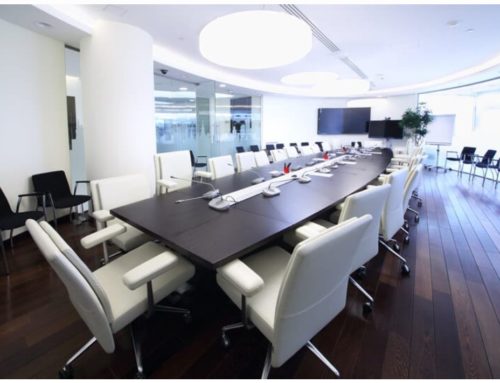In a 2013 report published by the OECD, it is stated that technology plays a key, if not leading, role in the teaching and learning environment. Yet, there is a distinct gap in the amount of time children spend using technology at home versus at school.
One such technology available for transforming learning is the Interactive Projector.
Classrooms today don’t look much like they did a decade ago. Instead of sitting in rows of tables and chairs while a teacher lectures from the front of the classroom, scribbling down notes from a blackboard, today’s children are learning in more flexible classroom designs while utilizing educational technology.
Technology is an integral part of many classrooms, where collaborative work and student-centered learning is made easier. Today’s children are “digital natives” – meaning they are born in the digital age, becoming naturally familiar with technology and digital devices rather than learning how to use them as adults (known as “digital immigrants”).
Interactive projectors can be the solution – a cost effective way to adopt technology that also allows for a collaborative classroom environment where both teacher and students can interact and contribute to the lesson, making learning a more active, and productive experience.
What is an Interactive Projector?
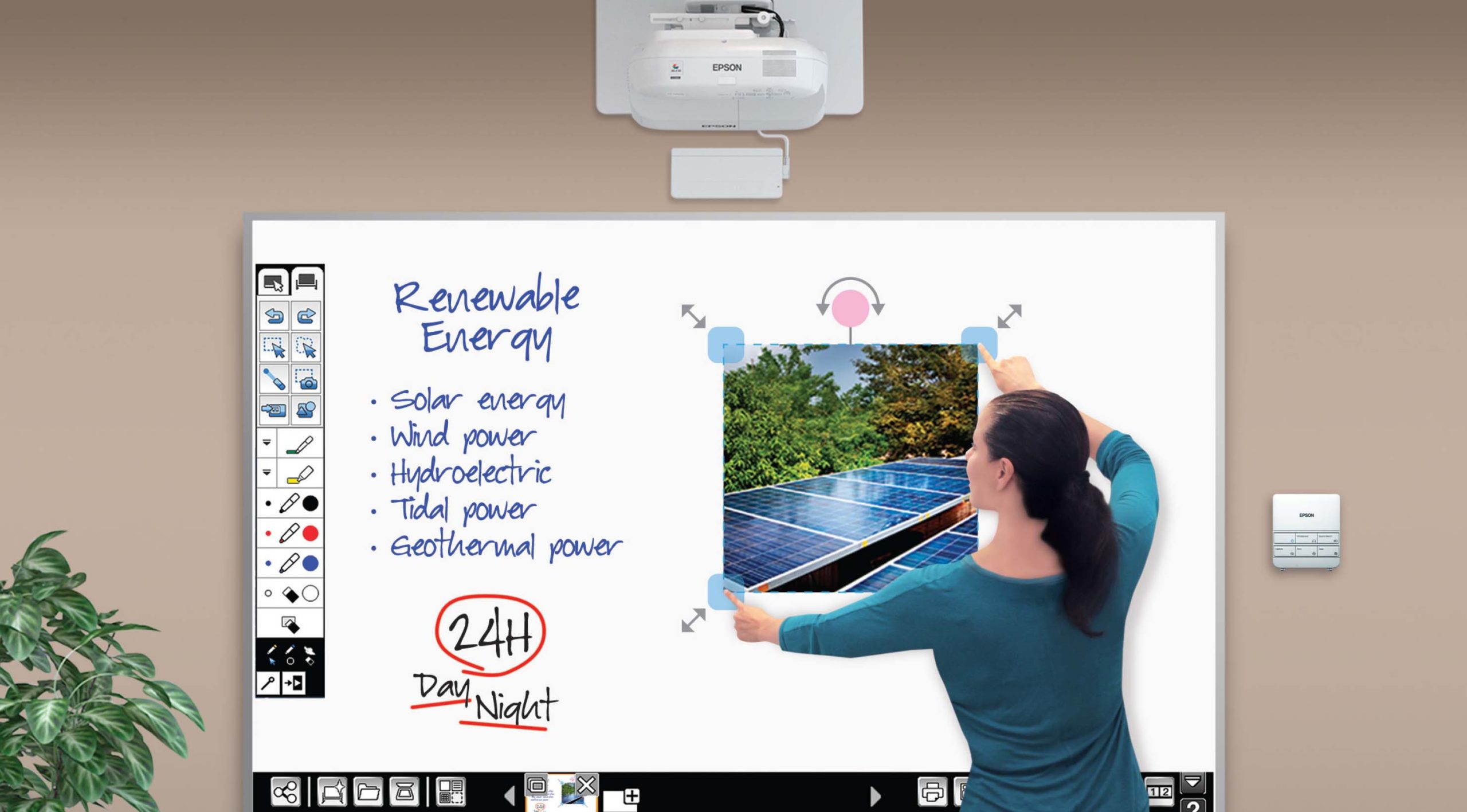
Interactive projectors are generally ultra-short throw projectors with projection mapping. The images and words are projected onto a projector screen or whiteboard, much like your standard projectors.
Interactive projectors take the standard projector and throw in some sensors to track movements and add them to the image. Unlike most projectors, however, interactive projection gives you the ability to interact with what you are projecting. They are able to do this with special sensors.
There are two types of interactive projectors – DLP and Infrared, though DLP is the most common.
DLP Interactive Projectors
DLP (Digital Light Processing) interactive projectors emit a special pattern into the image that is projected. This pattern appears on the screen so quickly that the human eye can’t detect it. The interactive pen “sees” the pattern and relays the data back to the projector, where your movements are reflected back onto the surface.
So, when you are using the pen, the projector is able to pick up the movements. This information is understood by the projector and your device. Depending on your specific projector, some can even copy what the pen has done while saving the changes on the original document.
DLP (Digital Light Processing) uses a chip made of tiny microscopic mirrors and a spinning color wheel to create an image. DLP projectors deliver sharp images, don’t need any filters, have a better response time as well as 3D capabilities.
Infrared Interactive Projectors
Infrared projectors work in a simpler process than a DLP projector. Besides the normal lens on the projector, there’s also a special camera. When an interactive pen is used on the projected image, the pen reflects infrared light to the special camera. The movement is then reflected back to the main projected image.
Some of the newer interactive projector models enable you to interact by touch instead of using a special pen. These displays don’t rely on a projector or any device. They come with software, a remote control, or sometimes a stylus pen. You interact with the interactive display like you do your touchscreen cell phone and tablet.
How to Use Interactive Projectors to Increase Student Engagement?
For many adults, memories of their classroom learning experience likely include an image of squinting students shifting around the room and dodging each other’s heads while trying fruitlessly to copy down class notes.
Wouldn’t it be great if all students could see and participate?
Thankfully, for today’s students, it’s possible because projectors have come a long way. They are interactive, their display size is much bigger and brighter, and the software used helps teachers create a classroom environment where participation flows easily between students at their desk to the front of the room. In a classroom that uses the newest generation of interactive projectors, lessons are more dynamic and student engagement increases.
Here are some proven strategies that can be adopted:
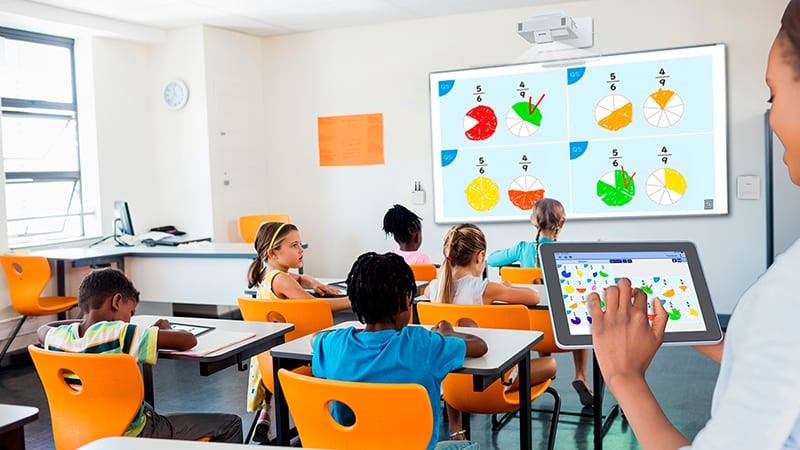
WOW Kids with Videos
We all know how frustrating it is to sit behind the “tall person” at the movie theater, and we certainly don’t want that for our students. The problem with flat screens is they restrict the size of the image, which creates barriers (sometimes literally) for active viewing.
Because we often can’t control all aspects of classroom configuration, interactive projectors solve this problem in a major way. These interactive projectors bring the big screen to your classroom with up to 100-inch screen projections on any surface (even a wall) and, remarkably, with no glare. Unlike a bulky flat screen, you can rest assured that all students can view the screen from any angle, keeping them interested and engaged.

Use Interactive Digital Content
Get students involved in the lesson. Gone are the days when the teacher was the only one allowed to draw on the touch-screen device. Let students manipulate content using their fingers or pens. Online games like Quizlet, Socratic and Kahoot become even more fun when played at super-size. Or try the online science experiments at Go-Lab, in which students can build their own circuits, test gravity, buoyancy, and more.
Teachers can also collaborate with students’ mobile devices, with the ability to connect up to 50 laptops, tablets or smartphones to the interactive projector via the network.

Create a Super Sized Display!
You have the option of using two projectors side by side to create an ultra-wide, interactive display. The interactivity between these two devices can be used to project an image on one side while utilizing interactive content on the other.
With “drag and drop” movable pieces and the ability to write at the same time, students can solve math problems and revise essays together. Not to mention, the relatively low cost of interactive projectors, as compared to flat screens, makes having two in the same classroom actually achievable for most schools.

Model your Thinking
One of the best methods of engaging students is to show your thought process as you work through a piece of reading, an experiment, or a problem. Now this is easier than ever. With an interactive projector, you can use a document camera, tablet, or other device to take pictures of real objects and then project those images to large-scale. You and your students might work together to mark up passages for close reading, solve a complicated math problem, or show the parts of a leaf or a frog’s digestive system.

Stay on top of classroom management through content sharing
When you want students to dive deeply into the lesson, you can easily share your projection screen with student devices. Integrating interactive projectors with student devices, such as Chromebooks, PCs, Androids, or Apple products, allows you to send a math problem or exit-ticket prompt to students for individual completion.
In addition, once complete, you can review those student responses using built-in projector software, selecting individual student screens to project back on the board. This is a great tool for student accountability, while also providing an easy means for immediate feedback.
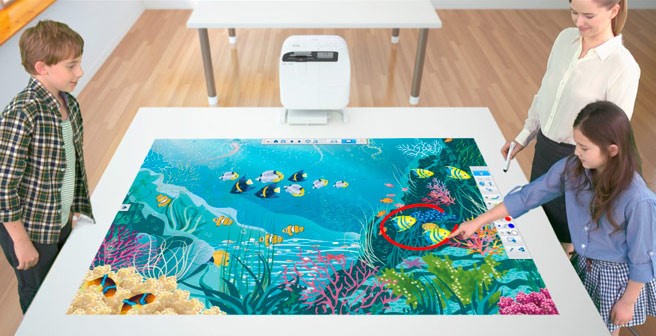
Take your Content to New Surfaces
Because interactive projectors do not have defined borders, learning is not limited. You can create an interactive experience on any surface. In fact, you can even project on tables.
For example, you can project a map onto a classroom table so students can mark and draw the best path to take from point A to point B. This level of flexibility means you can take your students’ learning to the place that best meets their needs.
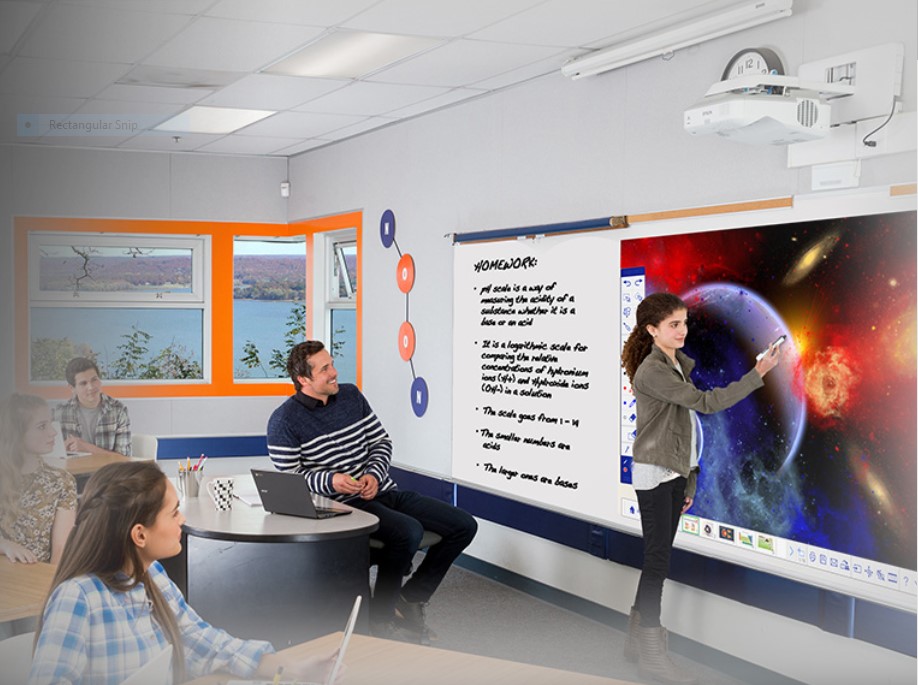
Set the mood with interactive classroom decor
Setting the mood for learning can require a lot of money, time, and effort, especially when it comes to decorating an entire wall. However, with the beautiful, large display of an interactive projector, you can create homely, relaxing, and educationally sound decor in seconds.
On a cold, gloomy winter day, project a beautiful, high-definition fireplace video, complete with crackling wood, to create a comfortable, warm environment for learning. Or liven the mood by projecting a beautiful beach scene. You can find high-definition videos to support your content, too. If, for instance, you are studying the rain forest, you could project a beautiful rain forest scene, complete with ambient rain forest white noise. With an interactive projector, you can turn any wall into classroom decor made for learning.
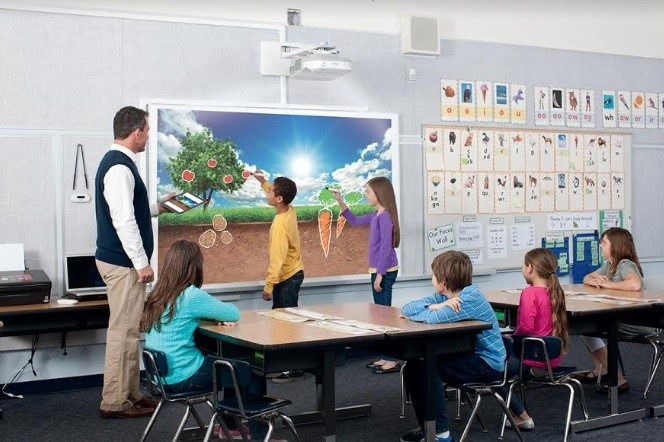
Take a Virtual Field Trip
Creating beautiful scenes on your walls is a great start, but why be confined by the walls of the classroom when your interactive projector can take your students to new places? You can use your interactive projector to create a global classroom, beyond the walls, without ever leaving your school.
Go on a Google Lit Trip and engage your students with an interactive journey into their favorite books; join surgeons in the operating room for a live open-heart surgery. With your interactive projector, you can rest assured that all students will have a front seat to the action.
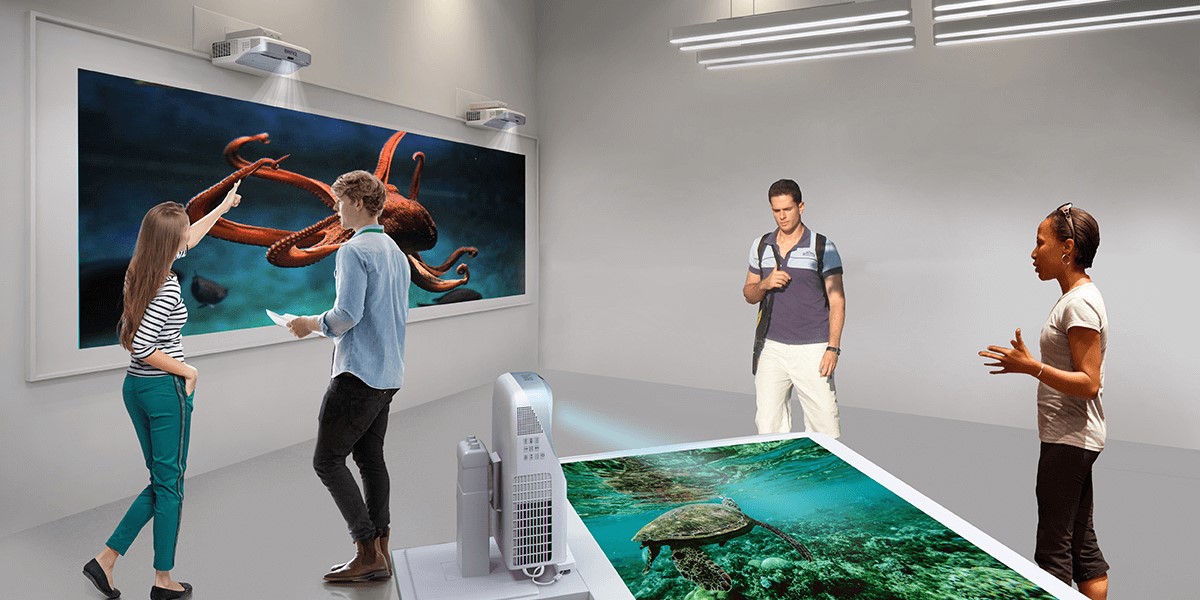
Hold Meet-ups with other Classes
After visiting these new places, you now can invite experts from all over the world into your classroom via Skype or Google Hangouts. Students can interact with authors, scientists, athletes, politicians, and even other students from across the world, creating a truly global classroom, with just the touch of a button.
Plus, with the large display and high quality of the interactive projector, your students will feel like your visitor is right in the room with them.
How to Choose the Right Interactive Projector for your Classroom?
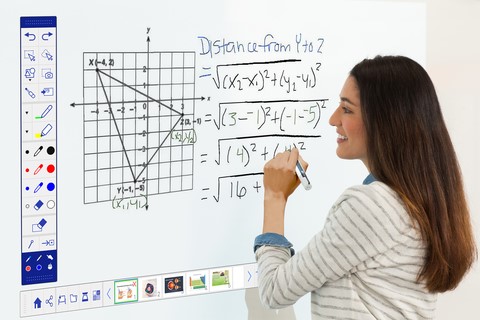
There are myriad projectors available in the market today. So how is a school IT manager to choose?
Although budget will arguably be the most important factor, there are two additional decisions you need to make before buying new equipment:
- What size will it need to be; and
- What features should it have?
Size of screen and classroom

Did you know that 58 per cent of children in an average classroom can’t read the information on a screen if it’s 70 inches or less? This is according to a study by Radius Research, which highlights how important screen size is in the classroom.
When you are choosing a projector, you will need to balance size (of both the screen and room) with budget. Bigger is likely going to be better, but too big is unnecessary.
To find that middle ground, we advise using the 4/6/8 rule popular with AV specialists.
What is 4/6/8 rule?
In short, this is a way to compare room size to screen size. It helps you find the perfect balance based on the type of viewing a class is likely to be doing – essentially, your screen height should either be 1/4, 1/6 or 1/8 the distance to the furthest viewer. It’s 1/4 for when you display technical details, 1/6 for presentations, and 1/8 for movie viewing.
For example, if the distance to your farthest student is 6 metres, and you are giving a basic presentation, your screen height should be 1 metre (that’s around an 80-inch screen). If the classroom is bigger, the screen should be too. If students can shuffle closer, you can opt for a smaller screen.
‘
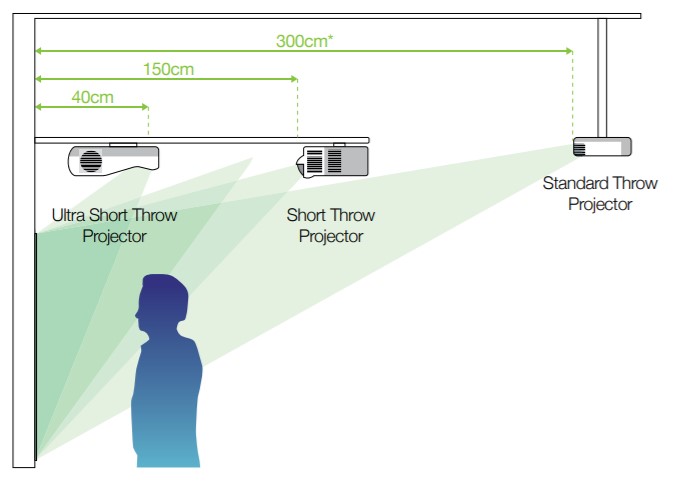
What features do you want in your Interactive Projector?
UAE is a nation with its finger on the pulse of modern technology, and the classroom should be no different. After all, we are trying to set children up with the skills for life, right?
School IT managers can add extra levels of technology engagement to the classroom with an interactive projector. You can wirelessly sync projectors to multiple devices, including Chromebooks, allowing you to seamlessly share content from device to device. The projectors can also be used for kinesthetic learning: kids can annotate the virtual screen with special pens, their fingers, or through their devices.
The benefits of interactive projectors will change the way we retain information fed to us. It will revolutionize the learning of children. Interactive projectors are a fantastic addition to any classroom.
For the installation of an interactive whiteboard or assistance with your custom audio visual requirements, contact our Audio Visual Solutions Expert today for a free demo and consultation.
Author


